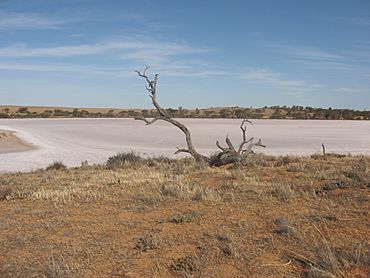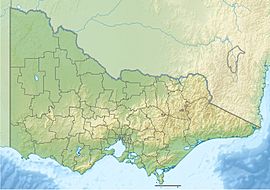Murray-Sunset National Park facts for kids
Quick facts for kids Murray-Sunset National ParkVictoria |
|
|---|---|
|
IUCN Category II (National Park)
|
|

Pink Lakes (salt lakes) in the national park.
|
|
| Nearest town or city | Mildura |
| Established | 26 April 1979 |
| Area | 6,330 km2 (2,444.0 sq mi) |
| Managing authorities | Parks Victoria |
| Website | Murray-Sunset National Park |
| See also | Protected areas of Victoria |
The Murray-Sunset National Park is a huge national park in Victoria, Australia. It is the second largest park in the state! You can find it in the northwest corner of Victoria, right next to South Australia. The park also borders the Murray River to the north.
This amazing park covers about 633,000 hectares (that's a lot of land!). It is about 440 kilometers northwest of Melbourne. The park was officially created on April 26, 1979. While a main road, the Sturt Highway, goes through the north, much of the park is a wild, remote area.
Contents
Park History and Pink Lakes
The Murray-Sunset National Park was first created in 1979. Later, in 1999, it grew even bigger. It expanded to include the special area known as Pink Lakes State Park.
Why the Lakes are Pink
The lakes in this park are called "Pink Lakes" for a cool reason. In late summer, they turn a distinct pink color! This happens because of a tiny plant called Dunaliella salina, which is a type of algae. This algae makes a special red pigment called beta-carotene. It is the same stuff that makes carrots orange!
Salt Mining History
The Pink Lakes area was once a very busy place for making salt. From 1916 to 1975, a large salt industry operated here. At its busiest time, workers harvested ten thousand tons of salt! This salt was then sent by train from Lake Crosbie, Lake Becking, and Lake Kenyon to a nearby town called Linga.
Park Management
The Murray-Sunset National Park is managed together with several other important parks. These include the Hattah-Kulkyne National Park, Wyperfeld National Park, Lake Albacutya Park, and Murray-Kulkyne Park. They are all part of the Victorian Mallee Parks system.
Old Railway and Huts
You can also find some interesting historical items in the park. There is an old railway line, called the Nowingi line, that ends at the remains of a gypsum mine. Gypsum is a mineral used in things like plaster. Other old buildings, like Shearer's Quarters and Mopoke Hut, were built in the 1960s. They were used as places for graziers (people who raise livestock) to stay.
Plants and Animals of the Park
The park is home to a huge variety of life. Over 600 different types of plants have been found here. There are also more than 300 kinds of birds!
Amazing Plants
Some of the special plants you might see include the Murray lily and the silvery emu-bush. You can also find saltbush, buloke trees, and porcupine grass. The park also has different types of mallee eucalypts, like the blue-leaved mallee.
In spring, the park becomes a colorful display of wildflowers. Look for beautiful spider orchids, azure sun orchids, desert heath-myrtles, and bright poached-egg daisies.
Wildlife You Might See
Many interesting animals live in the park. You might spot Emus, which are large, flightless birds. Huge wedge-tailed eagles soar in the sky. On the ground, you could see both western grey kangaroos and red kangaroos hopping around.
Important Bird Area
Most of the Murray-Sunset National Park is part of something called an "Important Bird Area" (IBA). This special area is recognized by BirdLife International. It is important because it has a unique type of mallee habitat. This habitat is home to several threatened bird species. These include the malleefowl, the black-eared miner, and the mallee emu-wren. Protecting this area helps these rare birds survive.
Things to Do in the Park
The Murray-Sunset National Park is a great place for people who love to walk and explore nature. It is the closest semi-arid (dry) region to Melbourne, making it a popular spot for bushwalkers.
Walking Tracks
There are several walking tracks to enjoy. You can take shorter walks around Lake Crosbie and Lake Kenyon. For a longer adventure, try the three-day Sunset walking track. If you plan to hike, remember that fresh water is hard to find here. Hikers usually rely on water tanks that park rangers keep filled.
Visiting the Pink Lakes
The Pink Lakes are a major attraction. These are medium-sized salt lakes. As mentioned before, in late summer, they get their amazing pink color. This happens because of a red pigment called carotene, which is made by the algae Dunaliella salina. It is a truly unique sight to see!



